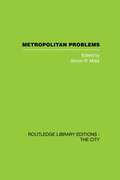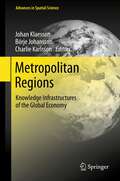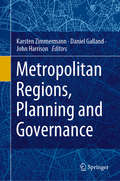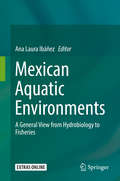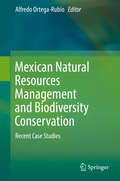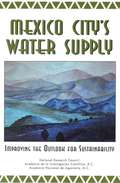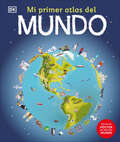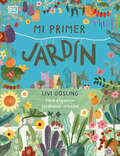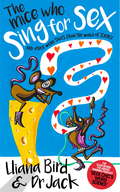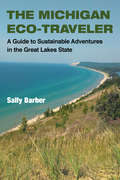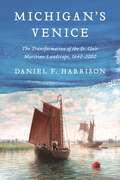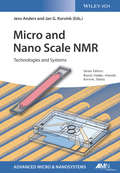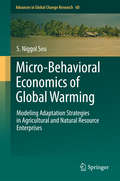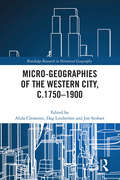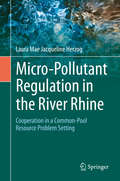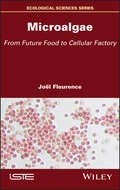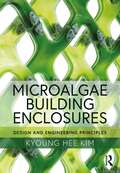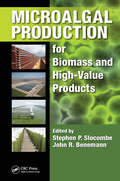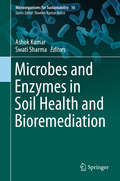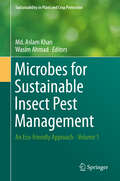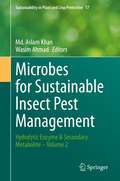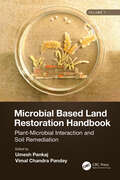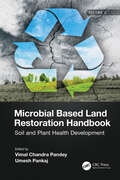- Table View
- List View
Metropolitan Problems
by S. MilesMetropolitan Problems is the end-product of one of the most dynamic research programmes of its kind ever conceived and executed. The book, which took three years to complete, represents the culmination of a two year study that was highlighted by a conference held in toronto in 1967. In the early 1960s, the bureau of Municipal Research (in metropolitan Toronto) decided that a significant way for it to celebrate Canada's centennial would be to initiate a systematic international study of the world's metropolitan areas. The study, with the official cooperation of the United Nations, was designed to produce positive insights into the methods of coping with the interlocking sets of problems associated with the expansion of the modern metropolis. Twelve papers on various aspects of metropolitan problems were commissioned from an international body of experts. Working with these experts were study groups drawn from forty major metropolitan centres throughout the world. After making exhaustive studies of their respective urban centres, the groups reported their findings and submitted detailed briefs through their representatives at the conference. Throughout the symposium, a conscious effort was made to examine single aspects of social, economic and physical change within the overall perspective of the metropolis. The book reflects this approach. Each chapter directs attention to specific problems of the metropolis, problems resulting from the contradiction between accelerating technology and our ability to cope with the incredible pace and rate of change. Together they prove that, despite differences in technology, culture, and political and social matters, the major urban areas of the world do have much in common. Emerging tendencies can be analysed and corrective and preventative measures be made through comparative analysis. This book was first published in 1970.
Metropolitan Regions
by Charlie Karlsson Johan Klaesson Börje JohanssonMetropolitan growth has been dramatic in the past several decades, and today metropolitan regions are recognized as the main driving forces in national growth and development as well as in national and global innovation processes. The purpose of this book is to contribute to a better understanding of how metropolitan regions and their subsystems interact and compete, why they differ in their capacity to nurture innovation and growth, and how metropolitan policies must be designed to secure the region's long-term vitality. To that end, it presents new contributions on theories of urban growth, institutions and policies of urban change, and case studies of urban growth prepared by international experts.
Metropolitan Regions, Planning and Governance
by Karsten Zimmermann Daniel Galland John HarrisonThe aim of this book is to investigate contemporary processes of metropolitan change and approaches to planning and governing metropolitan regions. To do so, it focuses on four central tenets of metropolitan change in terms of planning and governance: institutional approaches, policy mobilities, spatial imaginaries, and planning styles. The book’s main contribution lies in providing readers with a new conceptual and analytical framework for researching contemporary dynamics in metropolitan regions. It will chiefly benefit researchers and students in planning, urban studies, policy and governance studies, especially those interested in metropolitan regions.The relentless pace of urban change in globalization poses fundamental questions about how to best plan and govern 21st-century metropolitan regions. The problem for metropolitan regions—especially for those with policy and decision-making responsibilities—is a growing recognition that these spaces are typically reliant on inadequate urban-economic infrastructure and fragmented planning and governance arrangements. Moreover, as the demand for more ‘appropriate’—i.e., more flexible, networked and smart—forms of planning and governance increases, new expressions of territorial cooperation and conflict are emerging around issues and agendas of (de-)growth, infrastructure expansion, and the collective provision of services.
Mexican Aquatic Environments: A General View from Hydrobiology to Fisheries
by Ana Laura IbáñezPursuing a multidisciplinary approach, this book highlights current challenges in, and potential solutions to, environmental water management in Mexico. It includes an essential review of current literature and state of the art research, providing a one-stop resource for researchers, graduate students and environmental water managers alike. The result of a cooperation between 35 researchers from seven Mexican academic institutions, two Federal Commissions and one international organization, the book links science to practice for living organisms and their environment, while also addressing anthropogenic effects on our water ecosystems. Particularly the book addresses the following subjects: Biodiversity in inland waters, physical and chemical characterization of inland waters, physico-chemical characterization of Mexican coastal lagoons, microbiota in brackish ecosystems, diversity associated with southern Mexico’s pacific coral reefs, fry fish stockings in aquatic epicontinental systems, a review of tuna fisheries in Mexico, fishery resource management challenges stemming from climate change, aquatic invasive alien species, harmful algal blooms, and aquatic protected areas, related ecological and social problems and the importance for fisheries’ yield.
Mexican Natural Resources Management and Biodiversity Conservation: Recent Case Studies
by Alfredo Ortega-RubioThis book presents valuable and recent lessons learned regarding the links between natural resources management, from a Socio-Ecological perspective, and the biodiversity conservation in Mexico. It address the political and social aspects, as well as the biological and ecological factors, involved in natural resources management and their impacts on biodiversity conservation. It is a useful resource for researchers and professionals around the globe, but especially those in Latin American countries, which are grappling with the same Bio-Cultural heritage conservation issues.
Mexico City's Water Supply: Improving the Outlook for Sustainability
by The Joint Academies Committee on the Mexico City Water SupplyThis book addresses the technical, health, regulatory, and social aspects of ground water withdrawals, water use, and water quality in the metropolitan area of Mexico City, and makes recommendations to improve the balance of water supply, water demand, and water conservation. The study came about through a nongovernmental partnership between the U.S. National Academy of Sciences National Research Council and the Mexican Academies of Science and Engineering. The book will contain a Spanish-language translation of the complete English text.
Mi primer atlas del mundo (Children's Illustrated Atlas)
by DKMi primer atlas del mundo' da vida al planeta con coloridos mapas y datos fascinantes sobre los países del mundo.Cada mapa está rebosante de información, combinando ilustraciones con fotografías que representan puntos clave sobre cada país. El atlas incluye un mapa mundial, con un mapa político para cada continente. Los niños aprenderán a leer mapas con leyenda, brújula y escala. Este libro encantador e informativo será una adición imprescindible para la biblioteca de cualquier niño.DK&’s 'Mi primer atlas del mundo' brings the world to life with colorful maps and fascinating facts about the countries of the world.Each map is bursting with information, combining colorful icons with photographs representing key points about each country. The atlas includes a world map, with a political map for each continent. Children are shown how to read a map and use a key, compass, and scale. This charming and informative book is a key addition to every child&’s library.
Mi primer jardín (My First Series)
by Livi GoslingUn primer libro de jardinería para niños, con divertidos proyectos y actividades, para que los más pequeños aprendan a cuidar el medioambiente jugando y disfruten de su pasión por las flores y las plantas.Los niños descubrirán cómo preparar la tierra antes de sembrar, qué y cuándo plantar, dónde conseguir semillas, cómo trasplantar, podar y hacer compost, qué verduras y hierbas cultivar. ¡Todo lo necesario para crear increíbles espacios verdes y llenar de color y aromas tu casa, balcón o jardín!Perfecto para aprender cómo crecen las plantas y tener un primer contacto con el huerto o el jardín.Con texto sencillo, instrucciones paso a paso y divertidas ilustraciones.Ideal para fomentar el respeto por la naturaleza y el medioambiente.¡Enseña a tus hijos a sembrar, plantar, regar y cuidar de las plantas y observa como ser convierten en auténticos jardineros!----------------------This is the perfect gardening book for kids who want to plant fruit and vegetables, create mini-farms from plants, and go on wildflower missions.No matter how tiny your space, you can be a gardener. Livi Gosling has advice on creating places for plants to live in your home, scavenging from the recycling to create a vegetable kingdom, and adding a splash of color to grey city streets with your own wildflower seed mix.This great gardening book for children features: Livi&’s striking illustrations that make this book a keepsake as well as a practical guide.Kid-friendly text makes the topic fun and encourages a sense of wonder at nature.A strong eco message.With clear step-by-step instructions on how to get seeds, plant them, and help them grow, and plenty of inspiration andhelpful tips, this nature book teaches children the basics for growing different plants, from gorgeous flowers to delicious fruit and vegetables.
The Mice Who Sing For Sex: And Other Weird Tales from the World of Science
by Lliana Bird Dr Jack LewisLliana Bird and Dr Jack Lewis tackle the strange and surreal phenomena from the depths of the oceans to the limits of the far flung universe; the dark corners of your laundry basket to the forgotten compartments of your fridge. Packed with unusual facts and stories of the absurd each of the fascinating insights is told with the Geek Chic team's inimitable humour and wit.An hilarious exploration all things bizarre from the world of science, The Mice Who Sing for Sex takes on weighty issues including heavy metal loving sharks, life-threatening skinny jeans, our impending jellyfish apocalypse and of course, the singing mice of the title.
The Mice Who Sing For Sex: And Other Weird Tales from the World of Science
by Jack Lewis Lliana BirdLliana Bird and Dr Jack Lewis tackle the strange and surreal phenomena from the depths of the oceans to the limits of the far flung universe; the dark corners of your laundry basket to the forgotten compartments of your fridge. Packed with unusual facts and stories of the absurd each of the fascinating insights is told with the Geek Chic team's inimitable humour and wit.An hilarious exploration all things bizarre from the world of science, The Mice Who Sing for Sex takes on weighty issues including heavy metal loving sharks, life-threatening skinny jeans, our impending jellyfish apocalypse and of course, the singing mice of the title.
Michael Balz: Shells and Visions
by John ChiltonThis book presents a review of the work of the architect Michael Balz, pioneer of concrete-shell architecture. It discusses his projects, both realized and unbuilt, many being designed in collaboration with the renowned Swiss engineer Heinz Isler.Profusely illustrated with original drawings and photographs, Michael Balz: Shells and Visions caters to the increasing interest in the design and construction of free-form reinforced concrete shells consequent on the advent of 3D modelling and form-finding software. The book describes architectural designs and practical construction issues to motivate contemporary shell designers.Balz’s experience of dealing with such difficulties as incompatibility with non-structural features and the insertion of windows into shells, and the assessment of buildings’ long-term performance allow readers to learn more easily how to cope with such issues in their own work.The book introduces Michael Balz, his early work with other architects, including his work on pneumatic forms with Frei Otto, and his evolution into an exponent of organic architecture. It then discusses completed projects, including the outdoor Theater unter den Kuppeln (1976), Ballettsaal (1979) and Balz House (1981). Competitions Balz entered and unrealized shell projects also receive attention, as does his work on the urban scale, highlighting conceptual designs of mega-cities. His visionary megastructures encourage the exploration of innovative solutions for city spaces by architects faced with today’s increased urbanization. Michael Balz: Shells and Visions will be of interest to students and professionals in the fields of architecture, structural engineering, building and urban design. It’s reflections on the cultural and contextual aspects of Balz’s work will help the architectural historian to appreciate its long-term significance.
The Michigan Eco-Traveler: A Guide to Sustainable Adventures in the Great Lakes State
by Sally BarberMichigan offers some of the most wonderfully diverse recreation opportunities in the country. The Michigan Eco-Traveleris for a new and growing breed of leisure traveler and adventurer--the individual seeking to experience the pleasant peninsulas responsibly by minimizing his or her eco-footprint. The book introduces readers to the importance of eco-friendly travel and highlights some of the best eco-conscience venues across the state that offer activities from golfing to skiing to sailing and much more. The book also examines environmental pressures on the state's recreational resources, revealing the critical need for joining together in conservation practices, and offers travelers helpful tips for evaluating the sustainability of their own favorite recreational spots. Whether you're a weekend traveler, extreme adventurer, or family on vacation, The Michigan Eco-Travelerlights the way to a greener getaway. Naturalists, conservationists, and hospitality experts will find the book equally helpful in responding to the ever rising demand for sustainable recreation.
Michigan’s Venice: The Transformation of the St. Clair Maritime Landscape, 1640–2000
by Daniel F. HarrisonFew maritime landscapes in the Great Lakes remain so deeply and clearly inscribed by successive cultures as the St. Clair system—a river, delta, and lake found between Lake Huron and the Detroit River. The St. Clair River and its environs are an age-old transportation nexus of land and water routes, a strategic point of access to maritime resources, and, in many ways, a natural impediment to the navigation of the Great Lakes. From Indigenous peoples and European colonizers to the modern nations of Canada and the United States, this work traces the region’s transformation through culturally driven practices and artifacts of shipbuilding, navigation, place naming, and mapmaking. In this novel approach to maritime landscape archaeology, author Daniel F. Harrison unifies historiography, linguistics, ethnohistory, geography, and literature through the analysis of primary sources, material culture, and ecological and geographic data in a technique he calls "evidence-based storytelling." Viewed over time, the region forms a microcosm of the interplay of environment, culture, and technology that characterized the gradual shift from nature to an industrial society and a built environment optimized for global waterborne transport.
Micro and Nano Scale NMR: Technologies and Systems (Advanced Micro and Nanosystems)
by Jens Anders Jan G. Korvink Oliver Brand Gary K. Fedder Christofer Hierold Osamu TabataThis must-have book is the first self-contained summary of recent developments in the field of microscale nuclear magnetic resonance hardware, covering the entire technology from miniaturized detectors, the signal processing chain, and detection sequences. Chapters cover the latest advances in interventional NMR and implantable NMR sensors, as well as in using CMOS technology to manufacture miniaturized, highly scalable NMR detectors for NMR microscopy and high-throughput arrays of NMR spectroscopy detectors.
Micro-Behavioral Economics of Global Warming
by S. Niggol SeoThis book presents a foundation for studying the micro-behavioral economics of global warming. The author develops an empirical model, named the Geographically-scaled Micro econometric model of Adapting Portfolios (G-MAP) in response to climatic changes and risks. The G-MAP model is applied to observed decisions of agricultural and natural resource enterprises in Sub-Saharan Africa and South America. The author describes the five applications of the model: the G-MAP animal species, the G-MAP agricultural systems, the G-MAP natural resource enterprises, the G-MAP climate risk, and the G-MAP public adaptations. The micro-behavioral economics of global warming and the G-MAP models are evaluated against the three alternative modeling traditions: The first is the Agro-Economic Models (AEM) based on crop simulations of selected crops under elevated CO2 conditions; The second is a family of econometric studies of grain yield changes caused by yearly weather fluctuations; The third is the Agro-Ecological Zone (AEZ) method hinged crucially on the AEZ classifications of ecosystems. The author offers a refreshing look at the traditional economics of global warming, unraveling a broad array of adaptation strategies adopted by managers of agricultural and natural resource enterprises in Sub-Saharan Africa and South America. The book demonstrates that the micro-behavioral economics dynamically integrates multiple disciplines in a cohesive way - including economics, psychology, climate science, ecosystem studies, agronomy and animal science - into the decision-making framework of an individual agent. The G-MAP models provide a guide map of adaptation strategies for the humanity's enduring journey of battling global climatic changes in this century and beyond.
Micro-geographies of the Western City, c.1750–1900 (Routledge Research in Historical Geography)
by Alida Clemente; Dag Lindström; Jon StobartThis book examines the overlapping spaces in modern Western cities to explore the small-scale processes that shaped these cities between c.1750 and 1900. It highlights the ways in which time and space matter, framing individual actions and practices and their impact on larger urban processes. It draws on the original and detailed studies of cities in Europe and North America through a micro-geographical approach to unravel urban practices, experiences and representations at three different scales: the dwelling, the street and the neighbourhood. Part I explores the changing spatiality of housing, examining the complex and contingent relationship between public and private, and commercial and domestic, as well as the relationship between representations and lived experiences. Part II delves into the street as a thoroughfare, connecting the city, but also as a site of contestation over the control and character of urban spaces. Part III draws attention to the neighbourhood as a residential grouping and as a series of spaces connecting flows of people integrating the urban space. Drawing on a range of methodologies, from space syntax and axial analysis to detailed descriptions of individual buildings, this book blends spatial theory and ideas of place with micro-history. With its fresh perspectives on the Western city created through the built environment and the everyday actions of city dwellers, the book will interest historical geographers, urban historians and architects involved in planning of cities across Europe and North America.
Micro-Pollutant Regulation in the River Rhine: Cooperation in a Common-Pool Resource Problem Setting
by Laura Mae HerzogThis book investigates how actors organize in order to solve a water quality problem. Research on the use of environmental resources has mainly focused on the circumstances needed for users to self-organize or to maintain an already sustainable way of resource use. Few studies have investigated the reasons why actors start to cooperate when they are faced with an environmental problem. Actor networks in three regions of the Rhine catchment area are scrutinized regarding a) actors’ cooperation pattern when managing an environmental problem; and b) the factors that trigger actors in a common-pool resource situation to initiate cooperation. Water quality policy is analysed in two European countries – Germany and Luxembourg – and one non-European country - Switzerland –, providing an overview of the distinctive measures applied in these regions aiming to tackle the water quality problem of micro-pollutants in river surface water. Applying the social-ecological system framework (SESF) devised by E. Ostrom and her colleagues and Social Network Analysis (SNA), the current book combines qualitative and quantitative methods to answer the question of why actors cooperate in the management process of an environmental problem like water pollution.
Microalgae: From Future Food to Cellular Factory
by Joel FleurenceMicroalgae and cyanobacteria are the first organisms in the oceanic food chain and are essential producers of oxygen and effective carbon dioxide traps. They are traditional sources of food proteins for Aztec, African and Asian populations, and some of them have even acquired the status of superfoods. Microalgae reviews the biological, ecological and biochemical characteristics of microalgae and cyanobacteria. They are true cellular factories, producing substances of interest such as original pigments, proteins and polysaccharides with biological activities. Their use covers many sectors of human activity including aquaculture, livestock breeding, agri-food, and human and veterinary medicine.This book presents their mode of production and the transformation processes that are applied to them, as well as the traditional and future valorization of algae. As they are a source of lipids and fatty acids, microalgae have become the focus of attention for the development of green fuels, such as biofuel.
Microalgae Building Enclosures: Design and Engineering Principles
by Kyoung Hee KimMicroalgae architecture has gained awareness for its biotechnical potential to achieve net-zero energy architecture while also promoting ecological sustainability and occupant well-being. Microalgae Building Enclosures: Design and Engineering Principles aims to provide design, engineering, and biotechnical guidelines for microalgae building enclosures that need to be considered for symbiotic relations among the built environment, humans, and ecosystems. Part I of the book introduces the theoretical background of microalgae as a bioremediator and future energy system and their potential roles toward sustainable and healthy built environments. Part II exemplifies interventions and multiple benefits of microalgae systems in product, architecture, urban, and infrastructure applications across the globe including Africa, Asia, Australia, Europe, South America, and North America. Part III explains the design and engineering criteria, biotechnical design requirements, and various performance metrics for microalgae architecture. Finally, Part IV investigates potential building applications in low-rise buildings, high-rise buildings, and energy-efficient retrofitting. The book also includes international case studies of microalgae building systems within various building types and climates. As one of the first books to comprehensively cover this emerging area of microalgae building enclosures, Microalgae Building Enclosures is an essential source for professionals and students looking to expand architectural discourse on nature integrated building systems to achieve the triple bottom line of sustainability.
Microalgal Production for Biomass and High-Value Products
by Stephen P. Slocombe John R. BenemannMicroalgae are a particularly interesting source of products that range from currently marketed human nutritionals and food ingredients, to potential sources of biofuels and animal feeds. Rapid advances in technology and commercial development are taking place worldwide. Importantly, algal cultivation does not compete with agriculture for land, water, and in some cases, fertilizer resources. Microalgal Production for Biomass and High-Value Products covers the field from a variety of perspectives with 14 chapters contributed by recognized academic experts and industrial practitioners. The book presents the latest technologies and innovations in algal biomass production, from cultivation in open ponds and photobioreactors, to strain selection, synthetic biology, pest control, harvesting, and processing. It explores novel algal products and addresses key issues, including markets, supply chains, business strategies, legal issues, current products, and future prospects. This book brings together the latest advances of interest to those already working in the field while providing an introduction to those beginning to learn about the promise of microalgae as a sustainable source of both specialty and commodity products. It gives stimulating overviews from many different perspectives that describe how laboratory and applied research are creating advances in commercial microalgae production. It also addresses the still many open questions and challenges in this field.
Microbes and Enzymes in Soil Health and Bioremediation (Microorganisms for Sustainability #16)
by Ashok Kumar Swati SharmaMicrobial enzymes play a vital role in maintaining soil health and removing pollutants from contaminated land. Soil microflora is closely associated with maintaining soil fertility, and the use of chemical pesticides, fertilizers and other volatile sprays in agriculture threatens the health ofthe microbial population in the soil. Every single particle of healthy soil contains millions of bacteria, which interact with the nutrients available, sustaining the nutrient cycle and making this microflora an essential component of life on earth. How do microbes help in the nutrient cycle? Either by intracellular digestion of macromolecules and converting these into smaller units in their metabolic pathways, or by secreting enzymes into the extracellular environment to facilitate the conversion of complex macromolecules into micro-molecules that can be easily absorbed by other living species. To meet demands for energy and food for the growing global population, it is important to protect agricultural land from contamination and maintain its productivity. Heavy metal ions from contaminated land canenter crops, fish or aquatic organismsvia contaminated water, and theseare then taken up by the human body, where they can accumulate and alter the normal microflora.The microbiological component of the soil is ahighly complex system and is still not fully understood. How do microbes survive in the changing physicochemical environment of soil?. This book helps readers understand the mechanism, various routes of microbialsoil remediation, the interactionsof different genera, and how microbial enzymes support the sustainable restoration of healthy soil.
Microbes for Sustainable Insect Pest Management: An Eco-friendly Approach - Volume 1 (Sustainability in Plant and Crop Protection)
by Md. Aslam Khan Wasim AhmadThis Volume comprises 14 chapters in an attempt to provide the reader with available information on safe and effective use of entomopathogens. Chapters in this book dealing with soil-borne entomopathogens and their phylogeny also provide a review on most updated information of their isolation and molecular identification. Employing fungal pathogens in biological control programmes plays a key role, and conidial thermotolerance and oxidative stress are examined in separate chapters. Entomopathogenic bacteria are able to kill their hosts quickly. An important contribution concerns informations provided upon bacterial cytotoxic factors on insect haemocytes. Nematodes are biological control agents safe to the environment. The information with respect to their direct and indirect effects on non-target organisms is provided. Viruses as highly specific, virulent candidates for use as biological insecticides are safe to non-target species. A separate chapter on the role of granuloviruses in IPM contributes a wealth of information. Biopesticides in combination with synthetic insecticides are reported as effective, economic, and eco-friendly. Understanding their interactions will certainly promote their uses. Finally, emphasis has been given on reviewing synergistic and antagonistic interactions of microbial and chemical pesticides, in other chapters.
Microbes for Sustainable lnsect Pest Management: Hydrolytic Enzyme & Secondary Metabolite – Volume 2 (Sustainability in Plant and Crop Protection #17)
by Md. Aslam Khan Wasim AhmadThe search for new strategies of pest control with safer molecules is currently of great importance and interest. Microbe-mediated biological crop protection is an attractive and promising technology with no concern for a negative impact on the environment and biodiversity. Microbial hydrolytic enzymes such as proteases, chitinases, lipases, etc. are attractive for this purpose. They present toxic properties and act synergistically to control pest attacks. Also, some metabolites, that microorganisms produce for their survival or defense, can be explored and exploited for plant protection. The focus of this Volume is on the potential of microbial hydrolytic enzymes and their metabolites in agroecosystem functioning. Subsequent chapters review topics such as microbial hydrolytic enzymes as powerful management tools, chitinases in IPM of agro-horticultural crops, metabolites as pesticides and the importance of the metabolites of entomopathogenic fungi, metabolites and virulence factors. Other topicas include: microbial-based nanoparticles, recombinant DNA technologies to improve the efficacy of microbial insecticides, the effects of entomopathogens on insect predators and parasitoids, and the management of major vegetable insect pests. This Volume provides detailed accounts on the safe use of microbial products for sustainable management of insect pests. Its aim is to build solid foundations for the students, teachers, and researchers interested in eco-friendly management of important insect crop pests.
Microbial Based Land Restoration Handbook, Volume 1: Plant-Microbial Interaction and Soil Remediation
by Umesh Pankaj Vimal Chandra PandeyPlant-microbe interaction is a powerful and promising link to mitigate the various kinds of stresses like drought, salinity, heavy metals, and pathogenic effects. It is more beneficial for crop improvement and sustainable approaches for reclamation of problematic soils. Taking a multidisciplinary approach, this book explores the recent uses of plant-microbe interactions in ecological and agricultural revitalization beyond normal agriculture practices and offers practical and applied solutions for the restoration of degraded land to fulfill human needs with food, fodder, fuel, and fiber. It provides a single comprehensive platform for soil scientists, agriculture specialists, ecologists, and those in related disciplines. Features • Presents cutting-edge microbial biotechnology as a tool for restoring degraded lands • Explores the aspects of sustainable development of degraded lands using microbe inspired land remediation • Highlights sustainable food production intensification in nutrient poor lands through the innovative use of microbial inoculants • Explains the remediation of polluted land for regaining biodiversity and achieving United Nations Sustainable Development Goals • Includes many real-life applications from South Asia offering solutions to today’s agricultural problems This book will be of interest to professionals, researchers, and students in environmental, soil, and agricultural sciences, as well as stakeholders, policy makers, and practitioners that have an interest in this field.
Microbial Based Land Restoration Handbook, Volume 2: Soil and Plant Health Development
by Vimal Chandra Pandey Umesh PankajMicroorganisms are a good indicator of soil health. Plant growth-promoting microorganisms protect plants from the stresses of water, salt, metal, biotic, and so on, and are well known for strategically modulating the plant mechanisms to defend and mitigate environmental stresses. Taking a multidisciplinary approach, this volume explores the role of plant microorganisms in ecological and agricultural revitalization beyond normal agriculture practices and offers practical and applied solutions for the restoration of degraded lands to fulfill human needs with food, fodder, fuel, and fiber. It also provides a single comprehensive platform for soil scientists, agriculture specialists, ecologists, and those in related disciplines. Features • Presents cutting-edge microbial biotechnology as a tool for restoring degraded lands • Explores the aspects of sustainable development of degraded lands using microorganism-inspired land remediation • Highlights sustainable food production intensification in nutrient-poor lands through innovative use of microbial inoculants • Explains the remediation of polluted land for regaining biodiversity and achieving United Nations Sustainable Development Goals • Includes many real-life applications from South Asia offering solutions to today’s agricultural problems This book will be of interest to professionals, researchers, and students in environmental, soil, and agricultural sciences as well as stakeholders, policy makers, and practitioners with an interest in this field.
